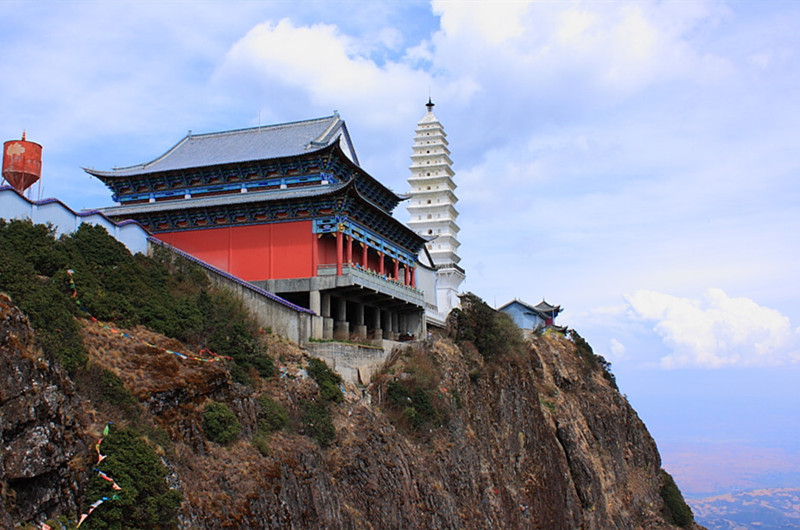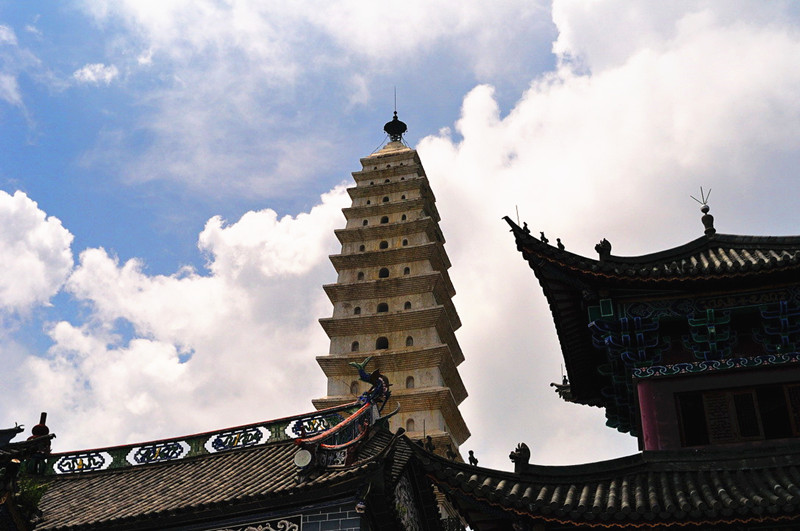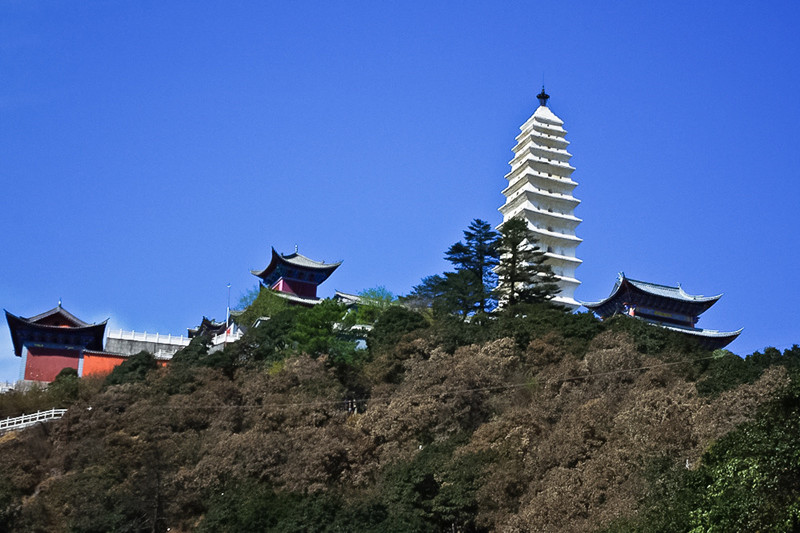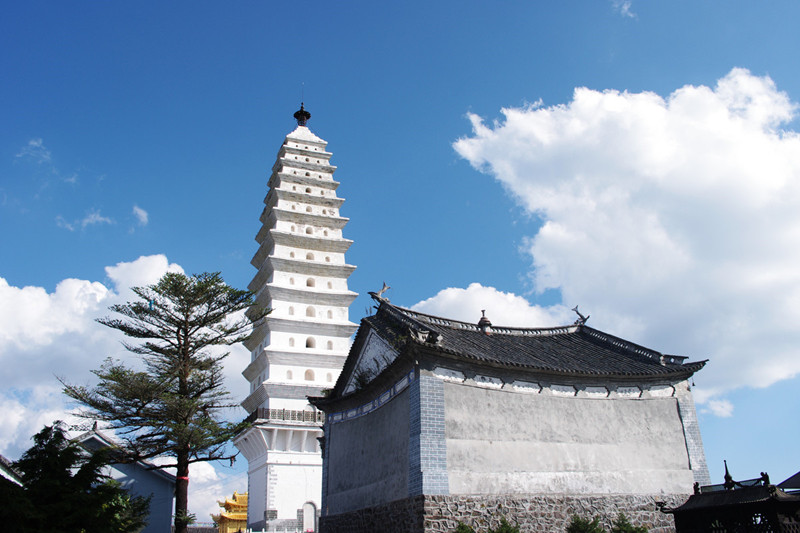Lengyan Pagoda of Jizu Mountain in Binchuan County, Dali
Overview
Lengyan Tower, located at the peak of Jizu Mountain (鸡足山) over 30 kilometers northwest of Binchuan County (宾川县), Yunnan Province, is a key cultural relic protected at the provincial level by Dali Prefecture (大理州). Jizu Mountain is a famous Buddhist holy site in Southeast Asia, serving as a convergence point for Han and Tibetan Buddhism, and is recognized as the birthplace of Zen Buddhism. It is also the site where the Buddha’s foremost disciple, Kasyapa (迦叶), established a spiritual practice. The mountain, known for its distinctive shape resembling a chicken’s foot, is classified as a national scenic area.
Introduction to the Attraction
Architectural Features
The Lengyan Tower is a thirteen-story, pagoda-style tower standing over 40 meters tall, with seven levels accessible to visitors. The original site of the tower was home to the Guangming Pagoda (光明宝塔), built during the Ming Dynasty (明朝). This earlier structure was described as having a square base with seven levels, each approximately one zhang high, and took seven years to complete. Unfortunately, during the Kangxi period of the Qing Dynasty (清朝), the governor Fan Chengxun (范承勋) fell prey to slander and ordered its demolition.
In 1929, after visiting Jizu Mountain, the then Governor of Yunnan, Long Yun (龙云), approved the construction of the Lengyan Tower on the original site of the Guangming Pagoda. The new tower took over three years to complete and has become a significant cultural landmark of Jizu Mountain. During the Second Sino-Japanese War, the Lengyan Tower served as a vital navigational beacon for the “Camel Peak Route” in the Dali area, contributing uniquely to the war effort.
Cultural Significance
Lengyan Tower houses several inscriptions, including Yang Mengnan’s (杨萌南) “Inscription of Lengyan Tower” (鸡足山楞严塔碑记), Zhou Zhongyue’s (周钟岳) “Epitaph of Lengyan Tower” (鸡足山楞严塔碑铭), and Long Yun’s (龙云) “Dharma Appearance is Majestic” (法相庄严), which reflect its profound cultural significance. Despite being constructed relatively recently, the tower inherits and advances the traditional styles of Dali’s ancient pagodas, symbolizing a historical continuum that has thrived for over a thousand years.
Scenic Views
The majestic architecture of the Lengyan Tower stands out beautifully against the backdrop of Jizu Mountain, serving as a prominent geographical landmark in the region. The tower’s exterior is gray-white and resembles the Qianxun Pagoda (千寻塔) of Chongsheng Temple (崇圣寺), though it is more slender. Notably, the second tier of the tower is surrounded by iron railings and features a corridor for visitors to enjoy panoramic views, supported by eight inverted triangular structures that give the appearance of a decorative “skirt,” infusing modern architectural elements.
Throughout the seasons, the scenery surrounding the Lengyan Tower transforms dramatically: in spring, it is adorned with blooming azaleas; in summer, it appears as a floating landmark amid the sea of clouds; in autumn, it stands out against the clear blue sky and lush trees; and in winter, it sparkles like crystal in the snow, becoming an indispensable part of Jizu Mountain.
Standing beneath the tower and gazing upward, one feels a sense of awe at the clouds racing across the sky. The tower, standing majestically between heaven and earth, evokes a profound appreciation for the beauty of ancient Chinese architecture. From the tower, one can admire the panoramic views of Cangshan (苍山) and Erhai Lake (洱海), where mountains and lush landscapes converge. Visitors can witness the sunrise to the east, the colorful clouds to the south, the vast Cang and Er lakes to the west, and the majestic Yulong Snow Mountain (玉龙雪山) to the north. This breathtaking scenery captivates the spirit and invites reflections on the wonders of nature.
Historian Xu Xiake (徐霞客), during his exploration of Jizu Mountain, was so enchanted that he spent several days there, famously remarking, “To see the sun in the east, the sea in the west, the clouds in the south, and the snow in the north—this combination is indeed extraordinary, but the pinnacle of Tianzhu Peak captures all these sights, making it not just the premier site of Jizu Mountain, but the foremost in all the realm.”
Conclusion
Today, the interior of the Lengyan Tower is no longer open to visitors, preventing direct access to its heights. However, the grandeur of the tower and the harmonious integration of architecture with nature continue to inspire awe and reflection. This tower, imbued with historical memories and spiritual significance, proudly stands in Dali, in the land of colorful clouds.
How to Get There
To reach Lengyan Tower, visitors can travel to Binchuan County by bus or car from Dali City. From Binchuan, it is a scenic drive or bus ride up to Jizu Mountain. Local transportation options include taxis or private vehicles, which provide flexibility for exploring the area.
Travel Tips
- Best Time to Visit: Spring and autumn offer the most comfortable weather and vibrant scenery.
- Clothing: Wear comfortable walking shoes and layered clothing as the weather can change quickly.
- Photography: Bring a camera to capture the stunning views and architectural details.
- Respect Local Customs: As a religious site, visitors should dress modestly and maintain a respectful demeanor.



Location:
















